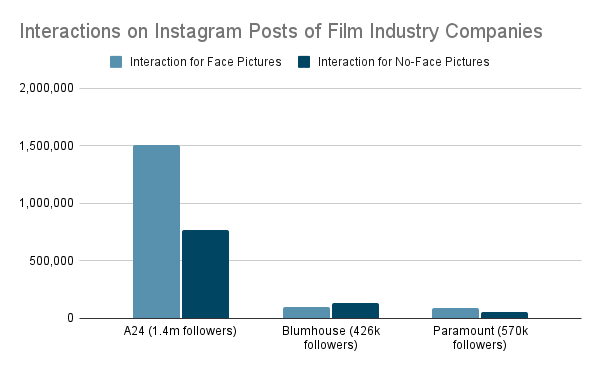Research shows that posting human faces increases interaction on Instagram—does this apply to the film industry?
For most people, posting their faces on Instagram is a terrifying ordeal. Fortunately, most people don’t have to post their face if they don’t want to. For celebrities, however, their faces are their marketing tool and the key to more interaction on Instagram.
According to Hootsuite, posting faces creates more interaction on Instagram (people are 38% more likely to "like" an Instagram post that features a human face). Digital Strike takes it one step further, claiming that using influencers and celebrities to promote your brand creates a shared sense of brand loyalty, which leads to more dedicated users of your product.
Combining these two best practices, I wondered if using the faces of celebrities in posts created more interaction on film-industry Instagram accounts. Specifically, I looked at three film production companies: A24, Blumhouse, and Paramount Pictures.
Because these accounts already have dedicated fan bases and at least 100,000 followers, I wanted to see if non-face Instagram posts generated the same amount of interaction, or if the celebrities’ fan bases brought in more.
Collecting Interaction on Instagram
For my data collection, I gathered all of the posts from each of the film production companies within one year (October 2021–October 2022), not including Reels/videos or those posted with a separate account because of Instagram’s new update where two accounts can share one post to both of their feeds. I sorted the remaining posts into those with faces and those with no faces, and randomly selected fifteen posts from each of those categories.
I also ran a test with an independent coder to test the reliability of my codebook. After going through two rounds of revisions with an independent coder, my Cohen’s kappa was 0.86 out of 1, indicating high reliability. I then coded all of my data with my codebook, which is shown below.
So, What Does The Data Say?
In analyzing my data, A24 had 51% more interaction on posts that had faces than those that did not. Paramount Pictures had 34% more interaction on face posts. An outlier, Blumhouse, had 22% more interaction on non-face pictures.

Blumhouse posted easy, recognizable things for their non-face posts, which could be the reason there was more interaction on non-face posts versus face posts. For example, they posted the mask from their movie The Black Phone, which was an extremely popular horror movie over the summer. The mask is almost as recognizable as a celebrity, which may have triggered the same recognition factor as using a face and possibly increased interaction. A24 and Paramount Pictures did not use easily recognizable inanimate objects as often, which could be the reason there was less interaction on non-face posts.
A24’s non-face posts mainly consisted of product advertisements. Because of the advertisement content on A24 versus Paramount Pictures and Blumhouse, non-face pictures could be considered less interesting to look at and may possibly be the reason they generated less interaction on Instagram.
A majority of Paramount Pictures’ face posts were throwbacks to older movies rather than promotions of new movies with current celebrities. It is possible that this created less interaction than Blumhouse’s content despite having over 100k more followers. Younger generations might not recognize these throwback movies and are therefore less likely to interact. In contrast, A24 was consistent with using recognizable celebrities such as Zendaya, Andrew Garfield, or Jamie Lee Curtis, which increased interaction significantly.
And What Does This Mean?
Overall, it appears that posts with celebrities’ faces in them do receive more interaction on Instagram in the film industry. More accounts would need to be studied and more posts would need to be considered in order to have a clearer picture, especially with the Blumhouse outlier.
Instagram is a platform that connects people to other people, so the human element is an important part of any profile. People feel stronger links with brands that emphasize that they are managed by people and are there for people. When using celebrities’ pictures in Instagram posts, film companies should use popular, recognizable celebrities when possible to appeal to younger generations. When growing your company, both within and outside of the film industry, faces are an important factor, so next time you post something for your company, consider taking a picture of a person.
